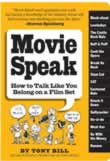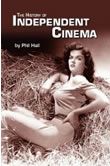 |
Picking up Movie Speak, one would think one was looking at another of those gimmicky little books that turn up alongside the till queue in Borders at Christmas. This is a case of deceptive packaging. Don't be fooled by the book's odd size, its bright yellow cover or its quirky cartoons. It has a whole lot more substance than these things suggest.
The aim of the book is to explain some of the jargon that surrounds the film production process. This will appeal to casual fans intrigued by the terms they see in film credits, but it also achieves what it says on the cover - it really will give you the kind of knowledge you need to get by on a film set. As such, it's an invaluable tool for beginner film makers. It would also make good reading for anyone about to sit a film studies exam, enabling them to throw in a lot of clever terms for extra marks.
Film language, like any other industry-specific terminology, has evolved in interesting ways. All sorts of strange terms crop up here, from Jonesy deck to pulling the pirate ship, bullshit glass to trombone gobble. An attempt is made not simply to explain their meanings but to provide a bit of background, an investigation into their origins.
If this sounds rather dry, don't worry. Author Tony Bill, one of the people who produced The Sting, uses lively prose and is not averse to humour. Breaking up the encyclopaedia-type listings are little anecdotes about his own experiences on set; these are both engaging and insightful. They help to put the rest of the writing into context. Quite a few famous names are mentioned and Bill's extensive knowledge of the film world gives the book an assured tone. There's also useful advice for people wanting to break into the industry.
If you were hoping for an amusing bit of trivia you could read in ten minutes, you may find Movie Speak rather heavy going. If, on the other hand, you're genuinely interested in finding out how the production process works, you're in luck. This is an accessible yet highly informative little book.
 |
This is a rare treat, a guidebook that's a pleasant read even well outwith the area that it covers. Taking as its central focus (so to speak) depictions of Paris on the silver screen, it engages and informs with a series of walks that take in a variety of landmarks as well as some sites likely only to be of interest to dedicated film scholars or die-hard fans. That's not to speak against it, for the intent is clearly two-fold - to show the Paris seen in film, and to highlight the films that show Paris.
Paris is a grand dame of the cinema world, sometimes recreated but usually used as shorthand for a certain sophistication (or, indeed, grime). She very rarely impersonates other cities, unlike that chameleonic character actor Toronto, and as such she's got more fans. Of course, it helps that she's been in cinema since the very beginning and is now a well established star.
Michael Schuermann is listed as a journalist, broadcaster and translator, but on this basis it'll be fair to call him an expert guidebook writer. This is a joy to read, and beyond its conversational tone, its crisp layout, it's a good set of walks.
There are ten in total, cleverly worked to start and end at Metro stations, with little overlap. Each takes a few hours, and as a whole they take in the usual highlights as well as a variety of other sites of interest. Useful recommendations on cafés, restaurants, and nightlife (both wholesome and otherwise) round it out.
Paris can be intimidating; the weight of history aside, it's a big and confusing place. However, the directions given are crisp and clear, the maps formatted to fit on a single page but perfectly readable. With the occasional aside to provide context it manages to cover a variety of topics in just the right amount of detail. There are digressions (as footnotes) into topics as diverse as oddities of the development of French cinema, the tendency of Presidents to grands-projets, and just what the different types of restaurants actually do.
As a guidebook then, it's pretty strong. As a film book it's not bad either, managing to mention a variety of genres and films. It explains why location based shooting has become more common as technology has improved and studios have lost their massive backlots, and it manages to straightforwardly explain the difference between Paris appearing in a British or American film and Paris appearing in a French one. It's got a huge list of films with locations one can visit, or at least look at from the street; indeed, it seems pretty complete. While it does focus quite heavily on recent films like Amelie and the Bourne series, that's largely because they used a huge number of locations in Paris and were massive hits. The only film whose absence is notable is a cult motor movie Rendezvous, but given that it's a short and is relatively obscure that can be excused.
As a physical object, this is a comfortable size for an inside jacket pocket, but it'll be more likely to get stuffed in a bag. It's robust enough to survive getting carried about for a couple of weeks, and it has a cover that doesn't scream 'Tourist', a still from Breathless. The maps, which are in landscape format, are clear, and the spine survives being held open to view them.
Paris Movie Walks is a rare treat, meeting the Reithean ideal - it educates, informs, and entertains.
 |
If you want to read about a subject as big as the history of independent cinema, you wouldn't expect it to come in a small book. This one is a weighty volume, written by a man with an equally weighty reputation - Phil Hall is an established film scholar and journalist who has written for the likes of The New York Times and works as an editor at Film Threat. But the famous picture of Jane Russell staring defiantly out from the front cover shows another side to the book and to its author. Hall loves films with attitude, and here his passion really comes across.
It takes a rebellious spirit to push forward any new technology. Hall's History carries us all the way through from early experimental silent works to the digital revolution and present day democratisation of film. He's most interested in the people who initiated change, and there are fascinating stories here about the challenges film faced as it developed, with established businesses often resistant to innovation. These look at personal as well as practical and economic issues, and there's also a lot of interesting material about social change - for instance, the gradually increasing involvement of African Americans in the industry.
This book is very much America-focused, which those interested in the important European contributions to independent film may find frustrating, but such is the detail Hall goes into that it would really be unreasonable to ask him to take on any more. He certainly knows his stuff - most of the prose flows effortlessly so that the reader is educated and informed without realising it's happening. In places, though, the delivery of facts does take on more of the quality of a list, and this can become hard going. One wonders if the author was rushed at these stages, or if he was asked to condense more fluid paragraphs.
How well one gets along with this sort of thing largely depends on one's attitude to history in general. If you enjoy taking a scholarly approach to film, you'll love the thoroughness and reach of this book. If you're a little hesitant, well, it isn't just a lecture - there are all sorts of entertaining stories here. Most readers will find that it works best as a book to dip in and out of, but in places it's really quite gripping, so don't start on it late in the evening when you have to get up early the next day.
Finally, in approaching this book, it's worth thinking about just what the term 'independent cinema' means. By the time you've finished reading, you may see it in a different way. Hall points out that many of the successful film figures we're familiar with today began their careers working independently, whilst others quit the big studio system later on in their careers when they wanted to take on more challenging projects. As such, this book is useful not just as a guide to the mavericks, but as a means of approaching the wider history of the cinema phenomenon.





















